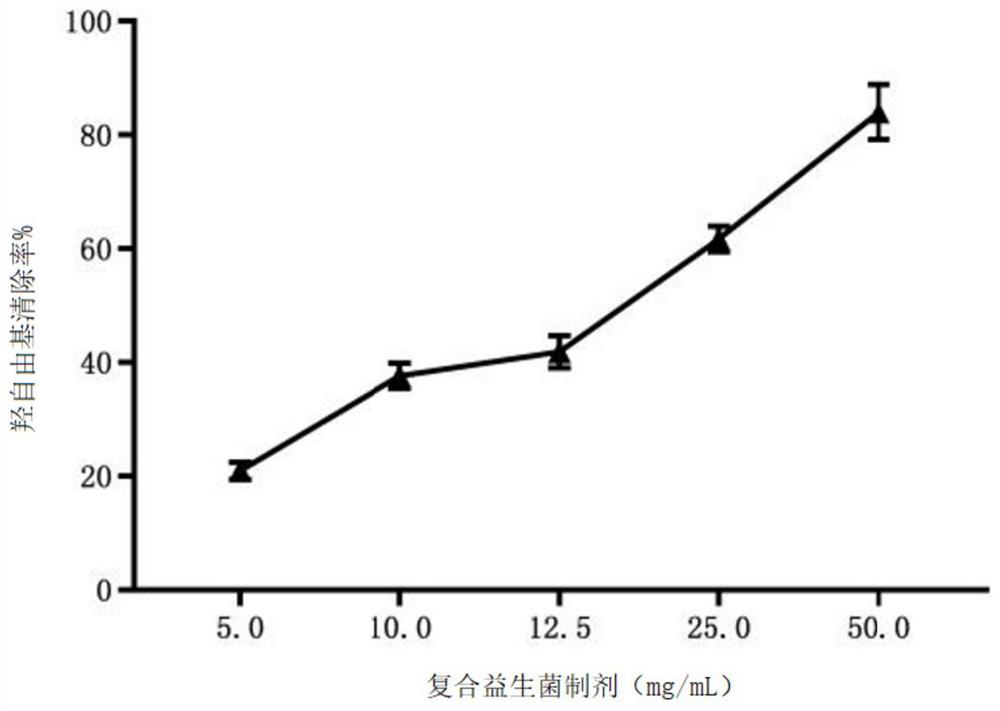New application of composite probiotic preparation to field of oxidation resistance
A compound probiotic and anti-oxidation technology, applied in the field of probiotics, can solve problems such as adverse reactions, decreased immune function, and poor anti-oxidation effect
- Summary
- Abstract
- Description
- Claims
- Application Information
AI Technical Summary
Problems solved by technology
Method used
Image
Examples
Embodiment 1
[0029] Preparation of compound probiotic preparation
[0030] The preparation method of compound probiotic preparation comprises:
[0031] a. Add sodium glutamate to the medium in an amount of 20g / L, stir for 10min, heat up to 55°C, and sterilize to obtain a sterilized medium; wherein, the formula of the medium is: skimmed milk powder 80g, whole milk Milk powder 2g, glucose 2g, peptone 10g, yeast extract powder 5g, anhydrous sodium acetate 2g, magnesium sulfate 0.58g and manganese sulfate 0.25g, add water to 1L, adjust the pH value to 6.6;
[0032] b. Inoculate Streptococcus thermophilus S709, Lactobacillus paracasei L578 and Lactobacillus helveticus L551 into the sterilized medium according to the volume ratio of 10% to ferment, and control the fermentation temperature to 42°C and ferment for 30 hours to obtain a fermented liquid, which is sterilized at high temperature, concentrated and dried to obtain a compound probiotic preparation.
Embodiment 2
[0034] Application of compound probiotic preparation in the preparation of antioxidant products
[0035] 1. Materials and equipment
[0036] 1.1, compound probiotic preparation (made in embodiment 1).
[0037] 1.2. Reagents: DPPH free radical detection kit, hydroxyl free radical detection kit, ABTS free radical detection kit, superoxide anion free radical detection kit (all provided by Suzhou Grace Biotechnology Co., Ltd.).
[0038] 2. Test method
[0039] 2.1. Detection of in vitro antioxidant capacity of compound probiotic preparations
[0040] 2.1.1. Sample pretreatment: Dilute the compound probiotic preparation in Example 1 with pure water to 5mg / mL, 10mg / mL, 25mg / mL, 30mg / mL, 50mg / mL, 200mg / mL, 300mg / mL concentrations for in vitro experiments.
[0041] 2.1.2. Determination of DPPH free radical scavenging rate of compound probiotic preparation
[0042] The DPPH free radical detection kit was used to measure the DPPH free radical scavenging ability of the compound prob...
Embodiment 3
[0059] Preparation of compound probiotic preparation
[0060] The preparation method of compound probiotic preparation comprises:
[0061] a. Add sodium glutamate to the medium in an amount of 20g / L, stir for 10min, heat up to 55°C, and sterilize to obtain a sterilized medium; wherein, the formula of the medium is: skimmed milk powder 80g, whole milk Milk powder 2g, glucose 2g, peptone 10g, yeast extract powder 5g, anhydrous sodium acetate 2g, magnesium sulfate 0.58g and manganese sulfate 0.25g, add water to 1L, adjust the pH value to 6.6;
[0062] b. Inoculate Streptococcus thermophilus S709, Lactobacillus paracasei L578 and Lactobacillus helveticus L551 into the sterilized medium according to the volume ratio of 10% to ferment, and control the fermentation temperature to 42°C , fermented for 30 hours to obtain a fermented liquid, and the fermented liquid was concentrated and dried to obtain a compound probiotic preparation.
[0063] Utilize the detection method in embodime...
PUM
 Login to View More
Login to View More Abstract
Description
Claims
Application Information
 Login to View More
Login to View More - Generate Ideas
- Intellectual Property
- Life Sciences
- Materials
- Tech Scout
- Unparalleled Data Quality
- Higher Quality Content
- 60% Fewer Hallucinations
Browse by: Latest US Patents, China's latest patents, Technical Efficacy Thesaurus, Application Domain, Technology Topic, Popular Technical Reports.
© 2025 PatSnap. All rights reserved.Legal|Privacy policy|Modern Slavery Act Transparency Statement|Sitemap|About US| Contact US: help@patsnap.com



